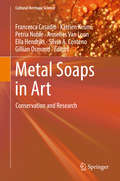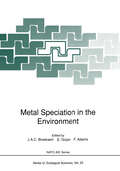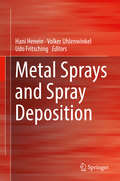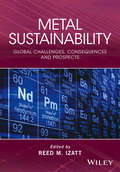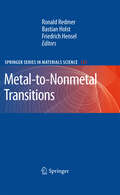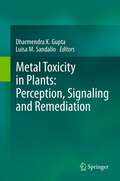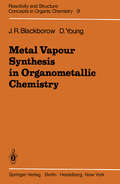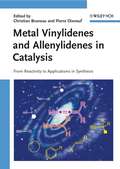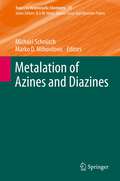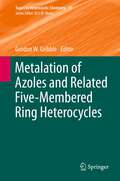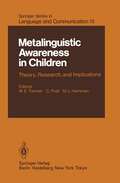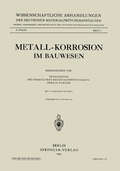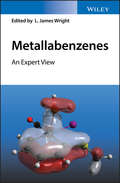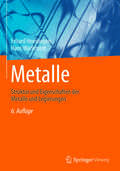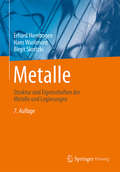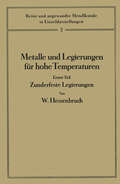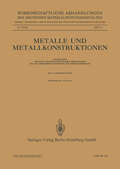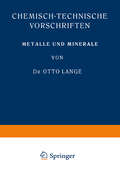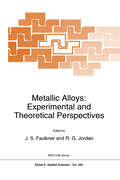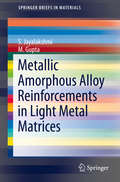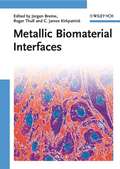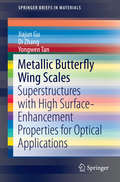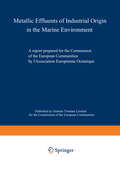- Table View
- List View
Metal Soaps in Art: Conservation and Research (Cultural Heritage Science)
by Francesca Casadio Katrien Keune Petria Noble Annelies Van Loon Ella Hendriks Silvia A. Centeno Gillian OsmondThis go-to reference work surveys the current state of knowledge in the field of metal soap-related degradation phenomena in art works. It contains detailed descriptions and images of the different phenomena and addresses the practical aspects of soap formation, preventive conservation, and treatment.The occurrence of metal soaps is one of the defining issues in the conservation of painted surfaces, and one that presently leaves innumerable open questions. It is estimated that around 70% of paintings in museum collections are affected by some form of metal soap-related degradation. In recent years, significant advances have been made in the detection and characterization of these compounds through interdisciplinary approaches including conventional spectroscopy and microscopy as well as emerging synchrotron-based techniques. This book for the first time captures a panoramic overview of the state of knowledge of metal soaps related to both scientific analysis and implications for conservation and treatment. It also critically examines open questions. The book is accessible to audiences with varied backgrounds (e.g. conservators, students of conservation science) while simultaneously presenting the technical details indispensable for academics and researchers active in this field.
Metal Speciation in the Environment (Nato ASI Subseries G: #23)
by J. A. C. Broekaert S. Gücer F. AdamsProceedings of the NATO Advanced Study Institute on Metal Speciation in the Environmental held in Cesme, Turkey, October 9-20, 1989
Metal Sprays and Spray Deposition
by Hani Henein Volker Uhlenwinkel Udo FritschingThis book describes and illustrates metal spray and spray deposition from the process engineering, metallurgical, and application viewpoints. The authors include step-by-step fundamental information for the metal spray process and detail current engineering developments and applications. They offer industry insight on non-equilibrium solidification processes for yielding stable metal structures and properties.
Metal Sustainability: Global Challenges, Consequences, and Prospects
by Reed M. IzattThe sustainable use of natural resources is an important global challenge, and improved metal sustainability is a crucial goal for the 21st century in order to conserve the supply of critical metals and mitigate the environmental and health issues resulting from unrecovered metals. Metal Sustainability: Global Challenges, Consequences and Prospects discusses important topics and challenges associated with sustainability in metal life cycles, from mining ore to beneficiation processes, to product manufacture, to recovery from end-of-life materials, to environmental and health concerns resulting from generated waste. The broad perspective presented highlights the global interdependence of the many stages of metal life cycles. Economic issues are emphasized and relevant environmental, health, political, industrial and societal issues are discussed. The importance of applying green chemistry principles to metal sustainability is emphasized. Topics covered include:• Recycling and sustainable utilization of precious and specialty metals• Formal and informal recycling from electronic and other high-tech wastes• Global management of electronic wastes• Metal reuse and recycling in developing countries• Effects of toxic and other metal releases on the environment and human health• Effect on bacteria of toxic metal release • Selective recovery of platinum group metals and rare earth metals• Metal sustainability from a manufacturing perspective• Economic perspectives on sustainability, mineral development, and metal life cycles• Closing the Loop – Minerals Industry Issues The aim of this book is to improve awareness of the increasingly important role metals play in our high-tech society, the need to conserve our metal supply throughout the metal life cycle, the importance of improved metal recycling, and the effects that unhindered metal loss can have on the environment and on human health.
Metal Sustainability: Global Challenges, Consequences, and Prospects
by Reed M. IzattThe sustainable use of natural resources is an important global challenge, and improved metal sustainability is a crucial goal for the 21st century in order to conserve the supply of critical metals and mitigate the environmental and health issues resulting from unrecovered metals. Metal Sustainability: Global Challenges, Consequences and Prospects discusses important topics and challenges associated with sustainability in metal life cycles, from mining ore to beneficiation processes, to product manufacture, to recovery from end-of-life materials, to environmental and health concerns resulting from generated waste. The broad perspective presented highlights the global interdependence of the many stages of metal life cycles. Economic issues are emphasized and relevant environmental, health, political, industrial and societal issues are discussed. The importance of applying green chemistry principles to metal sustainability is emphasized. Topics covered include:• Recycling and sustainable utilization of precious and specialty metals• Formal and informal recycling from electronic and other high-tech wastes• Global management of electronic wastes• Metal reuse and recycling in developing countries• Effects of toxic and other metal releases on the environment and human health• Effect on bacteria of toxic metal release • Selective recovery of platinum group metals and rare earth metals• Metal sustainability from a manufacturing perspective• Economic perspectives on sustainability, mineral development, and metal life cycles• Closing the Loop – Minerals Industry Issues The aim of this book is to improve awareness of the increasingly important role metals play in our high-tech society, the need to conserve our metal supply throughout the metal life cycle, the importance of improved metal recycling, and the effects that unhindered metal loss can have on the environment and on human health.
Metal-to-Nonmetal Transitions (Springer Series in Materials Science #132)
by Ronald Redmer Friedrich Hensel Bastian HolstMetal Toxicity in Plants: Perception, Signaling and Remediation
by Dharmendra K. Gupta and Luisa M. SandalioHeavy metal accumulation in soil and water from natural sources or anthropogenic activities have produced severe environmental contamination in some parts of the world due to the persistence of metals in the environment by their accumulation throughout the food chain. The purpose of this book is to present the most recent advances in this field, mainly concerning the uptake and translocation of heavy metals in plants, mechanisms of toxicity, perception of metal and regulation of cell response under metal stress. Another key feature of this book is related to the studies on signaling and remediation processes in recent years, which have taken advantage of recent technological advances including "omic" approaches. In recent years transcriptomic, proteomic and metabolomic studies have become very important tools for analyzing both the dynamics of changes in gene expression and the profiles of protein and metabolites under heavy metal stress. This information is also very useful for plotting the complex signaling and metabolic network induced by heavy metals, in which hormones and reactive oxygen species (ROS) also play an important role. Understanding the mechanism involved in sequestration and hyperaccumulation is very important to developing new strategies of phytoremediation, which are reviewed in several chapters of this book. The information included yields very stimulating insights into the mechanism involved in the regulation of plant responses to heavy metals, which in turn improve our knowledge of cell regulation under metal stress and the use of plants for phytoremediation.
Metal Vapour Synthesis in Organometallic Chemistry (Reactivity and Structure: Concepts in Organic Chemistry #9)
by J. R. Blackborow D. YoungMetal Vapour Synthesis (MVS) can be defined as; "The use in synthesis of high temper ature gaseous species such as metal atoms by their reactions with themselves or other materials in a condensed phase. " This short book, covering the literature up to the middle of 1979, describes MVS in organic chemistry; i. e. the reactions of metal atoms with various, predominantly organic, substrates in the synthesis and reactivity studies of organic and organometallic compounds. In order to effectively describe all the underlying principles and to present a coesive picture of pertinent metal atom processes in condensed organic phases, some inorganic substrates such as rare gases, dinitrogen, dioxygen, dihalo gens, and inorganic halides have been included. For similar reasons, we have used, where relevent, information provided by the closely related technique of Matrix Isolation Spec troscopy (MIS). After an introductory chapter which gives the basis principles and includes a brief critique of the technique, the book is divided into three further chapters dealing respec tively with (a) experimental techniques, (b) behaviour of metal atoms in matrices, and (c) results of prep~rative experiments. While not being encyclopaedic the book describes or refers to all noteworthy areas if not in the deliberately short text in the many tables and figures.
Metal Vinylidenes and Allenylidenes in Catalysis: From Reactivity to Applications in Synthesis
by Christian Bruneau Pierre DixneufFocusing on preparation and applications in synthesis and catalysis, this book finally closes a gap in the literature by summarizing this hot topic for the first time. As such, it gathers in one volume the key features of metal vinylidene and allenylidene complexes as well as reactive species and covers applications in metathesis, polymerization, molecular materials, carbon rich compounds and fine chemical production. The emphasis here is on the selective transformations of alkynes and enynes plus simple and complex molecules containing a triple C-C bond. The result is a must-have ready reference for organic, catalytic, complex, theoretical and polymer chemists, as well as those working with/on organometallics.
Metalation of Azines and Diazines (Topics in Heterocyclic Chemistry #31)
by Michael Schnürch and Marko D. MihovilovicReactions of Pyridines, Benzopyridines and Azapyridines with Organomagnesiums and Organolithiums, by Manfred Schlosser Lithiations and Magnesiations on Quinoline and Isoquinoline, by Floris Chevallier, Florence Mongin Metalation Reactions of Pyridines, Quinolines, and Isoquinolines with Ate Bases and Their Alkali Metal Salt-Modified Congeners, by Costa Metallinos, Kathryn Stromski Lithiations and Grignard Reactions on Pyrimidine and Quinazoline, by Andrej Kolarovic Other Stoichiometric Metalation Reactions on Pyrimidine and Quinazoline, by Philippe C. Gros Metalation of Pyrazine and Quinoxaline, by Nelly Plé1, Corinne Fruit Metalation of Pyridazine, Cinnoline, and Phtalazine, by Ernst Horkel
Metalation of Azoles and Related Five-Membered Ring Heterocycles (Topics in Heterocyclic Chemistry #29)
by Gordon W. GribbleT. L.S. Kishbaugh: Metalation of Pyrrole.- K.-S. Yeung: Furans and Benzofurans.- P. E. Alford: Lithiation-Based and Magnesation-Based Strategies for the Functionalization of Imidazole: 2001–2010.- L. Fu: Metalation of Oxazoles and Benzoxazoles.- S. Roy • S. Roy • G. W. Gribble: Metalation of Pyrazoles and Indazoles.- J. C. Badenock: Metalation Reactions of Isoxazoles and Benzisoxazoles.- Y.-J. Wu: Thiazoles and Benzothiazoles.- C. F. Nutaitis: Isothiazoles and Benzisothiazoles.- E. R. Biehl: Recent Advances in the Synthesis of Thiophenes and Benzothiophenes.- J. M. Lopchuk: Mesoionics.- J. M. Lopchuk: Azoles with 3-4 Heteroatoms.
Metalinguistic Awareness in Children: Theory, Research, and Implications (Springer Series in Language and Communication #15)
by J. Bowey R. Grieve M. Herriman M. Myhill A. Nesdale C. Pratt W.E. TunmerIn the past fi fteen years there has been a growi ng interest in the development of children's awareness of language as an object in itself -- a phenomenon now generally referred to as metal inguistic awareness. Until the publication of an earlier volume in the Springer Series in Language and Communication, The Chitd's Conoeption oi Language, edited by A. Sinclair, R. J. Jarvella, and W. J. M. Levelt, there had been no systematic treatment of metalinguistic awareness. The major goal of that volume was to map out the field of study by describing the phenomenon of interest and defining major theoretical issues. The aim of the present volume is to present an overview of metalinguistic awareness in children which reflects the current state of research and theory. The volume is divided into three major sections. The first considers various conceptual and methodological issues that have arisen from efforts to study metalinguistic awareness. It addresses such questions as what is metalinguistic awareness, when does it begin to emerge, and what tasks and procedures can be employed to assess its development in young children. The second sect ion cri ti ca 11y revi ews the research that has been conducted i nto the four general types of metalinguistic awareness -- phonologieal, word, syntactic, and pragmatic awareness. In the final section the development of metalinguistic awareness is examined in relation to general cognitive development, reading acquisition, bilingualism, and early childhood education.
Metall-Korrosion im Bauwesen (Wissenschaftliche Abhandlungen der Deutschen Materialprüfungsanstalten. II. Folge)
by Präsidenten des Staatlichen MaterialprüfungsamtsDieser Buchtitel ist Teil des Digitalisierungsprojekts Springer Book Archives mit Publikationen, die seit den Anfängen des Verlags von 1842 erschienen sind. Der Verlag stellt mit diesem Archiv Quellen für die historische wie auch die disziplingeschichtliche Forschung zur Verfügung, die jeweils im historischen Kontext betrachtet werden müssen. Dieser Titel erschien in der Zeit vor 1945 und wird daher in seiner zeittypischen politisch-ideologischen Ausrichtung vom Verlag nicht beworben.
Metallabenzenes: An Expert View
by L. James WrightThe only comprehensive book covering of advances in metallabenzene chemistry—written by the leading experts in the field Metallabenzenes: An Expert View provides comprehensive coverage of all aspects of metallabenzene chemistry, including syntheses, reactions, physical properties, and theoretical treatments of metallabenzenes. Fused ring metallabenzenes, heterometallabenzenes, and metallabenzenes that are p-bound to other metal fragments are also discussed in depth. Although benzene itself was discovered in 1825, it wasn’t until 1982 that the first metallabenzene was isolated. Since then, interest in these compounds has built steadily, and metallabenzene chemistry is now a flourishing sub discipline in its own right. A diverse range of synthetic approaches to these compounds have been devised, and new developments and discoveries have appeared regularly over the past several decades. Yet, until now, no books devoted to this fascinating and important class of chemical compounds have been available to researchers and students. This bookfills that gap in the literature with a comprehensive review of recent advances in metallabenzene chemistry theory and applications. Featuring contributions by an international group of experts in the field, each chapter summarizes important recent research in and significant contributions to various aspects of metallabenzene chemistry. Provides academics, researchers and graduate students with a comprehensive review of advances in metallabenzene research Covers fused-ring metallabenzenes—including metallanaphthalenes, metallabenzofurans, and metallabenzothiophenes—as well as p-bound heterometallabenzenes and metallabenzenes Reviews the latest computational studies that have led to the theoretical understanding of metallabenzenes Includes critical discussions of metallabenzene aromaticity, an area rarely covered by computational experts Metallabenzenes: An Expert View is an important working resource for those working in organometallic chemistry, aromaticity, coordination chemistry, theoretical chemistry, catalysis and materials science. It is also an excellent text for graduate-level courses in those areas.
Metallabenzenes: An Expert View
by L. James WrightThe only comprehensive book covering of advances in metallabenzene chemistry—written by the leading experts in the field Metallabenzenes: An Expert View provides comprehensive coverage of all aspects of metallabenzene chemistry, including syntheses, reactions, physical properties, and theoretical treatments of metallabenzenes. Fused ring metallabenzenes, heterometallabenzenes, and metallabenzenes that are p-bound to other metal fragments are also discussed in depth. Although benzene itself was discovered in 1825, it wasn’t until 1982 that the first metallabenzene was isolated. Since then, interest in these compounds has built steadily, and metallabenzene chemistry is now a flourishing sub discipline in its own right. A diverse range of synthetic approaches to these compounds have been devised, and new developments and discoveries have appeared regularly over the past several decades. Yet, until now, no books devoted to this fascinating and important class of chemical compounds have been available to researchers and students. This bookfills that gap in the literature with a comprehensive review of recent advances in metallabenzene chemistry theory and applications. Featuring contributions by an international group of experts in the field, each chapter summarizes important recent research in and significant contributions to various aspects of metallabenzene chemistry. Provides academics, researchers and graduate students with a comprehensive review of advances in metallabenzene research Covers fused-ring metallabenzenes—including metallanaphthalenes, metallabenzofurans, and metallabenzothiophenes—as well as p-bound heterometallabenzenes and metallabenzenes Reviews the latest computational studies that have led to the theoretical understanding of metallabenzenes Includes critical discussions of metallabenzene aromaticity, an area rarely covered by computational experts Metallabenzenes: An Expert View is an important working resource for those working in organometallic chemistry, aromaticity, coordination chemistry, theoretical chemistry, catalysis and materials science. It is also an excellent text for graduate-level courses in those areas.
Metalle: Struktur und Eigenschaften der Metalle und Legierungen
by Erhard Hornbogen Hans WarlimontDieses ausgezeichnete Standardwerk bietet eine Darstellung der Struktur und Eigenschaften der Metalle und ihrer Anwendungen als Werkstoffe. Die Autoren beschreiben im ersten, wissenschaftlichen Teil den atomaren und mikroskopischen Aufbau, die thermodynamischen und die grundlegenden physikalischen und mechanischen Eigenschaften der Metalle sowie die Grundlagen der thermisch aktivierten Reaktionen und der Phasenumwandlungen. Die wichtigsten experimentellen Untersuchungsmethoden werden erläutert, wobei die mikroskopischen und Beugungsverfahren einen Schwerpunkt bilden.Im zweiten, technischen Teil werden die Werkstoffgruppen der Metalle und ihre anwendungsbezogenen Eigenschaften behandelt. Dabei wird auf die zugrunde liegenden Legierungen und die Verfahren zur gezielten Einstellung ihrer Eigenschaften eingegangen. Schwerpunkte bei der Darstellung der Werkstoffe sind die Stähle, die teilchengehärteten Legierungen, die Magnetwerkstoffe und die pulvermetallurgisch hergestellten Werkstoffe. Außerdem werden die Oberflächeneigenschaften und die Verfahren zur Oberflächenbehandlung dargestellt.Das Buch wurde für die 6. Auflage gründlich überbearbeitet und aktualisiert und es erscheint jetzt im neuen Layout.
Metalle: Struktur und Eigenschaften der Metalle und Legierungen
by Erhard Hornbogen Hans Warlimont Birgit SkrotzkiMetalle mit ihren vielfältigen nützlichen Eigenschaften sind eine der wichtigsten Werkstoffgruppen. Ob elektrische und thermische Leitfähigkeit, Glanz, plastische Verformbarkeit oder auch chemische Beständigkeit – die charakteristischen Eigenschaften von Metallen lassen sich aus ihrem elektronischen Zustand ableiten. Das Buch führt in das interdisziplinäre Fachgebiet der Metallkunde ein und verbindet die Darstellung der physikalischen Struktur und der physiko-chemischen Eigenschaften der Metalle mit ihrer Anwendung als Werkstoffe.Die Autoren beschreiben im ersten, wissenschaftlichen Teil den atomaren und mikroskopischen Aufbau, die thermodynamischen und die grundlegenden physikalischen und mechanischen Eigenschaften der Metalle sowie die Grundlagen der thermisch aktivierten Reaktionen und der Phasenumwandlungen. Die wichtigsten experimentellen Untersuchungsmethoden werden erläutert, wobei die mikroskopischen und Beugungsverfahren einen Schwerpunkt bilden. Im zweiten, technischen Teil werden die Werkstoffgruppen der Metalle und ihre anwendungsbezogenen Eigenschaften behandelt. Dabei wird auf die zugrunde liegenden Legierungen und die Verfahren zur gezielten Einstellung ihrer Eigenschaften eingegangen. Schwerpunkte bei der Darstellung der Werkstoffe sind die Stähle, die teilchengehärteten Legierungen, die Magnetwerkstoffe und die pulvermetallurgisch hergestellten Werkstoffe. Außerdem werden die Oberflächeneigenschaften und die Verfahren zur Oberflächenbehandlung dargestellt. Das Buch wurde für die 7. Auflage gründlich überbearbeitet und aktualisiert. Das Kapitel Mechanische Eigenschaften wurde um das mechanische Verhalten bei hoher Temperatur stark erweitert und die berücksichtigt nun die einschlägigen Normen der Werkstoffprüfung. Das Kapitel Erstarrung wurde um die additive (generative) Fertigung ergänzt, die in den letzten Jahren als computerbasiertes Fertigungsverfahren Einzug in die Produktionstechnik gehalten hat.Als kompaktes Standardwerk eignet sich das Fachbuch sowohl für die berufliche Praxis als auch für das Studium an Universität und Hochschule. Dort richtet es sich an Studierende der Natur- und Ingenieurwissenschaften, insbesondere der Werkstoffwissenschaften.
Metalle und Legierungen für hohe Temperaturen: Erster Teil Zunderfeste Legierungen (Reine und angewandte Metallkunde in Einzeldarstellungen #2)
by W. HessenbruchDieser Buchtitel ist Teil des Digitalisierungsprojekts Springer Book Archives mit Publikationen, die seit den Anfängen des Verlags von 1842 erschienen sind. Der Verlag stellt mit diesem Archiv Quellen für die historische wie auch die disziplingeschichtliche Forschung zur Verfügung, die jeweils im historischen Kontext betrachtet werden müssen. Dieser Titel erschien in der Zeit vor 1945 und wird daher in seiner zeittypischen politisch-ideologischen Ausrichtung vom Verlag nicht beworben.
Metalle und Metallkonstruktionen
by O. Werner Walter Böhm Gerhard Schikorr B. Schulze B. Jolitz Ina Schikorr Eugen Deiß Kurt Albers E. Link Oskar Jacobi Nikolaus Ludwig Karl BoxhammerDieser Buchtitel ist Teil des Digitalisierungsprojekts Springer Book Archives mit Publikationen, die seit den Anfängen des Verlags von 1842 erschienen sind. Der Verlag stellt mit diesem Archiv Quellen für die historische wie auch die disziplingeschichtliche Forschung zur Verfügung, die jeweils im historischen Kontext betrachtet werden müssen. Dieser Titel erschien in der Zeit vor 1945 und wird daher in seiner zeittypischen politisch-ideologischen Ausrichtung vom Verlag nicht beworben.
Metalle und Minerale
by Otto LangeDieser Buchtitel ist Teil des Digitalisierungsprojekts Springer Book Archives mit Publikationen, die seit den Anfängen des Verlags von 1842 erschienen sind. Der Verlag stellt mit diesem Archiv Quellen für die historische wie auch die disziplingeschichtliche Forschung zur Verfügung, die jeweils im historischen Kontext betrachtet werden müssen. Dieser Titel erschien in der Zeit vor 1945 und wird daher in seiner zeittypischen politisch-ideologischen Ausrichtung vom Verlag nicht beworben.
Metallic Alloys: Experimental and Theoretical Perspectives (NATO Science Series E: #256)
by J. S. Faulkner R. G. JordanThe development of new materials is recognized as one of the major elements in the overall technological evolution that must go on in order to sustain and even improve the quality of life for citizens of all nations. There are many components to this development, but one is to achieve a better understanding of the properties of materials using the most sophisticated scientific tools that are available. As condensed matter physicists and materials scientists work toward this goal, they find that it is useful to divide their efforts and focus on specific areas, because certain analytical and theoretical techniques will be more useful for the study of one class of materials than another. One such area is the study of metals and metallic alloys, which are used in the manufacture of products as diverse as automobiles and space stations. Progress in this area has been very rapid in recent years, and the new developments come from many different countries. For these reasons the Advanced Research Workshop Programme in the NATO Scientific Affairs Division has seen fit to sponsor several meetings to bring together the researchers and students working in this field from the NATO countries and elsewhere. There have been a series of NATO-ASI's that have dealt with the results of research on the electronic structure of materials and the properties of metals, alloys, and interfaces. They are: "Electrons in finite and infinite structures" P. Phariseau and L.
Metallic Amorphous Alloy Reinforcements in Light Metal Matrices (SpringerBriefs in Materials)
by S. Jayalakshmi M. GuptaThis book presents cutting-edge research on the design and development of novel, advanced high-strength, light-weight materials via the incorporation of novel reinforcements, namely, metallic amorphous alloys/bulk metallic glasses (BMG), in light metal matrix composites (LMMCs) based on Al and Mg. The book begins with an introduction to conventional ceramic reinforced light metal matrix composites, along with the major drawbacks which limit their application. Metallic amorphous alloys/Bulk Metallic Glasses (BMG) are new class of metallic materials that are distinctly differently from conventional metals/alloys in terms of their structure and thermal behavior, and exhibit extremely high strength (1 to 2 GPa) and large elastic strain limit (1 to 2%). Given these unique properties, upon their incorporation into Al/Mg-matrices, they provide superior interfacial properties, i.e. high degree of compatibility with the matrix due to their metallic nature when compared to conventional ceramic reinforcements, and thereby significantly enhance the mechanical performance of LMMCs. Amorphous/BMG reinforced LMMCs is an emerging research field and the existing literature is meager. This book discusses the various processing methods that would be suitable for these novel materials. A comparison of mechanical properties and strengthening mechanisms of amorphous/BMG reinforced composites with those of conventional ceramic composites is presented. Future research directions and wider research potential of the novel materials are discussed, and prospective applications are highlighted. For ease of understanding and comparison, appropriate schematics, tables, and figures are provided.
Metallic Biomaterial Interfaces
by C. James Kirkpatrick Roger Thull J 252 Rgen Breme Jürgen BremeClearly divided into three sections on the interface influence of materials and surface modifications, the physical and physicochemical surface characterization, and the biological characterization of the interface and biosystem reactions, this book is the first to concentrate on the highly important area of metal-based implants and their improved functionality and acceptance by the body.
Metallic Butterfly Wing Scales: Superstructures with High Surface-Enhancement Properties for Optical Applications (SpringerBriefs in Materials)
by Jiajun Gu Di Zhang Yongwen TanThis book presents a method for replicating natural butterfly wing scales using a variety of metals for state-of-the-art applications requiring high surface-enhancement properties. During the past decade, three dimensional (3D) sub-micrometer structures have attracted considerable attention for optical applications. These 3D subwavelength metallic structures are, however, difficult to prepare. By contrast, the 3D superstructures of butterfly wing scales, with more than 175 000 morphologies, are efficiently engineered by nature. Natural butterfly wing scales feature 3D sub-micrometer structures that are superior to many human designs in terms of structural complexity, reproducibility, and cost. Such natural wealth offers a versatile chemical route via the replication of these structures into functional metals.A single versatile chemical route can be used to produce butterfly scales in seven different metals. These synthesized structures have the potential for catalytic (Au, Pt, Pd), thermal (Ag, Au, Cu), electrical (Au, Cu, Ag), magnetic (Co, Ni), and optical (Au, Ag, Cu) applications. Plasmon-active Au, Cu, Ag butterfly scales have exhibited excellent properties in surface-enhanced Raman scattering (SERS). The Au scales as SERS substrates have ten times the analyte detection sensitivity and are one-tenth the cost of their human-designed commercial counterparts (KlariteTM). Preliminary mechanisms of these surface-enhancement phenomena are also reviewed.
Metallic Effluents of Industrial Origin in the Marine Environment: A report prepared for the Directorate-General for Industrial and Technological Affairs and for the Environment and Consumer Protection Service of the European Communities by l'Association Europeenne Oceanique
by Association Européenne OcéaniqueBased on a unique industrial European membership, the European Oceanic Association, "non-profit Association has as its object the pooling of talents, resources and ex perience in the marine field with the purpose of promoting in Europe a concentration of efforts to foster the study and exploration of the seas in the light of their industrial exploitation" (articZe 2 of the statutes). The major concern of protecting the marine environment, whilst at the same time taking into consideration the present constraints on economic and industrial develop ment, has led the European Oceanic Association to establish constructive contacts with the Commission of European Communities. Following an interview in November 1972 with leading representatives of the Commission of European Communities and with the heads of the Environment and Consumer Pro tection Service, contacts were established which resulted, in May 1973, in the signing of a contract for studies between the Commission of European Communities and the European Oceanic Association. The essential point of the contract granted to the Associa tion was: " a contribution to the study of a preventative technology with the aim of arresting the deterioration of the marine environment by limiting and controlling present and future wastes". As a result of working groups between interested members of the Association, an area of study was chosen, comprising: - specific subjects relative to polluting elements or groups of elements, l.e: · chromium, · cadmium-zinc, · cyano-metallic compounds; - more general studies concerning monitoring systems; - specific and general recommendations.
